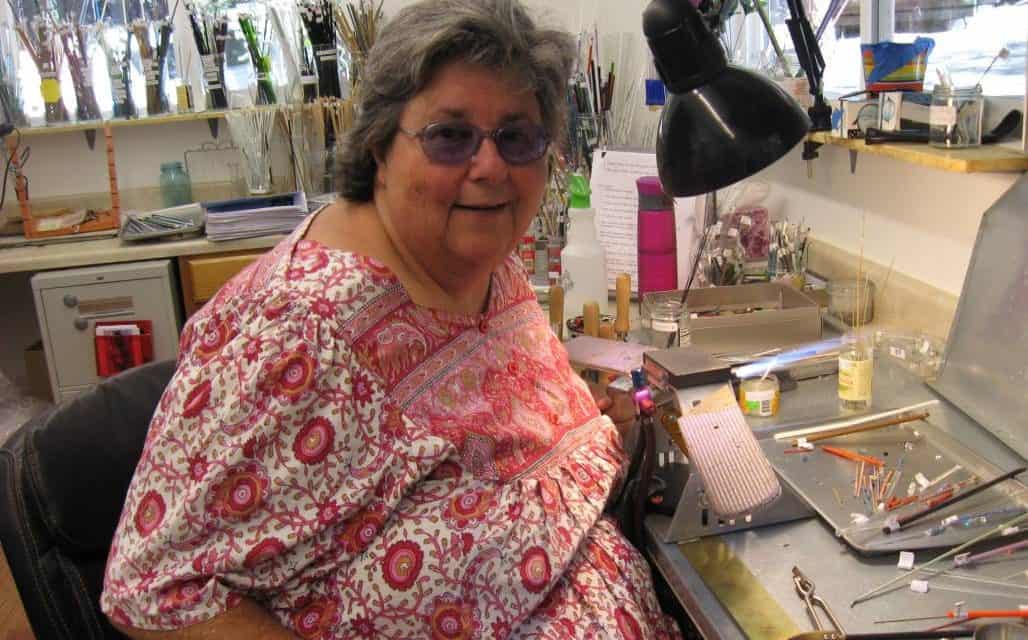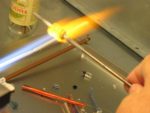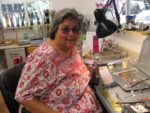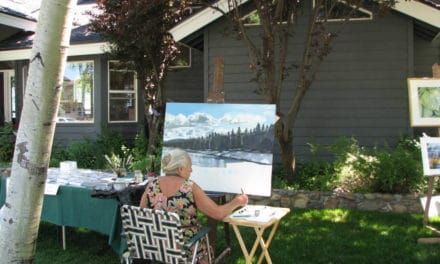The Art of Transforming, glass bead making in the Sierra.
by Lyn Walters
Glass bead artist Sara Conklin of Cromberg, CA, is really one of the last of the Magicians, the Babylonians, the Phoenicians. Her’s is an art where chemistry breaks down and alchemy takes over. “This work has changed my whole life!” Sara says. “I’m overwhelmed, captivated, in love, and excited every morning to wake up and see how the beads turned out from the day before.” Lampworked beads are verified to have existed at least 2500 years ago but are probably much older. Lampworking is a technique where the artist uses a torch to shape glass with tools and hand movements. Today modern torches are fueled by oxygen and propane or natural gas, but in the past lampworking was done with an oil lamp flame into which the artist blew air through a pipe. “You can’t be afraid of fire and do this work,” Sara says. Sara’s lovely studio, filled with natural light, is full of her beautiful work in all stages of production. Tools are laid out for the day’s work. Work from the day before is in the annealing (a hardening and cooling process) kiln. Beautiful finished beads are arranged to be turned into jewelry, and all the raw materials, mostly canes of colored glass are labeled and arranged in the windows. “All glass bead working is done by winding canes of melting glass around a central metal rod that creates the hole,” Sara explains. “I use Italian and American glass as well as borosilicate. ‘Boro’ is like Pyrex and very stiff and hard to melt. American and Italian glass are softer and require the glass maker to use specific physical actions to attain the desired results.” Initially, lampworked bead making is a study in chemistry. When she is not making beads, Sara is studying the work of other artists and researching the work of the past. She frequently attends workshops to learn new techniques and takes online classes. Two years ago she spent the entire winter in Tuscon at the Sonoran Glass Academy, soaking up inspiration from other glass workers. Mostly, learning the art takes hours in the shop experimenting with what the glass will do and under what conditions. Sara works about four hours a day. In that time she can produce several dozen beads or as few as four. In my session with her, she demonstrated many of the main techniques, from twisting, feathering and fritt work to reduction, which is the use of heat to bring out the latent silver in the glass to create iridescence, and striking, which involves cooling the bead then reintroducing it to the flame to intensify its color. Every stage is fluid. Mistakes may cause beads to be abandoned. And no two beads are the same. However, it is in her mission with cremains that Sara the Alchemist is most evident. In this process she literally transforms the funereal into the celestial. “Cremation Jewelry is a beautiful and sensitive way to honor a loved one’s memory and bring comfort to the survivors,” says Sara. In making these special beads using the ash of loved ones and even pets, Sara spends a great deal of time consulting with the client, thinking and even dreaming about how the work should proceed. She always tries to put a spiritual touch into these beads, whether by adding fine silver or perhaps a murrini (a small glass flower). Sara gives private lessons and will attend gatherings such as family reunions. She sells her work at the Plumas Arts gallery, at various art shows and online at http://www.etsy.com/shop/saraconklinglass. Her new website is http://cremationbeadsbysara.com/. She can be reached at mountainbead@gotsky.com.
















